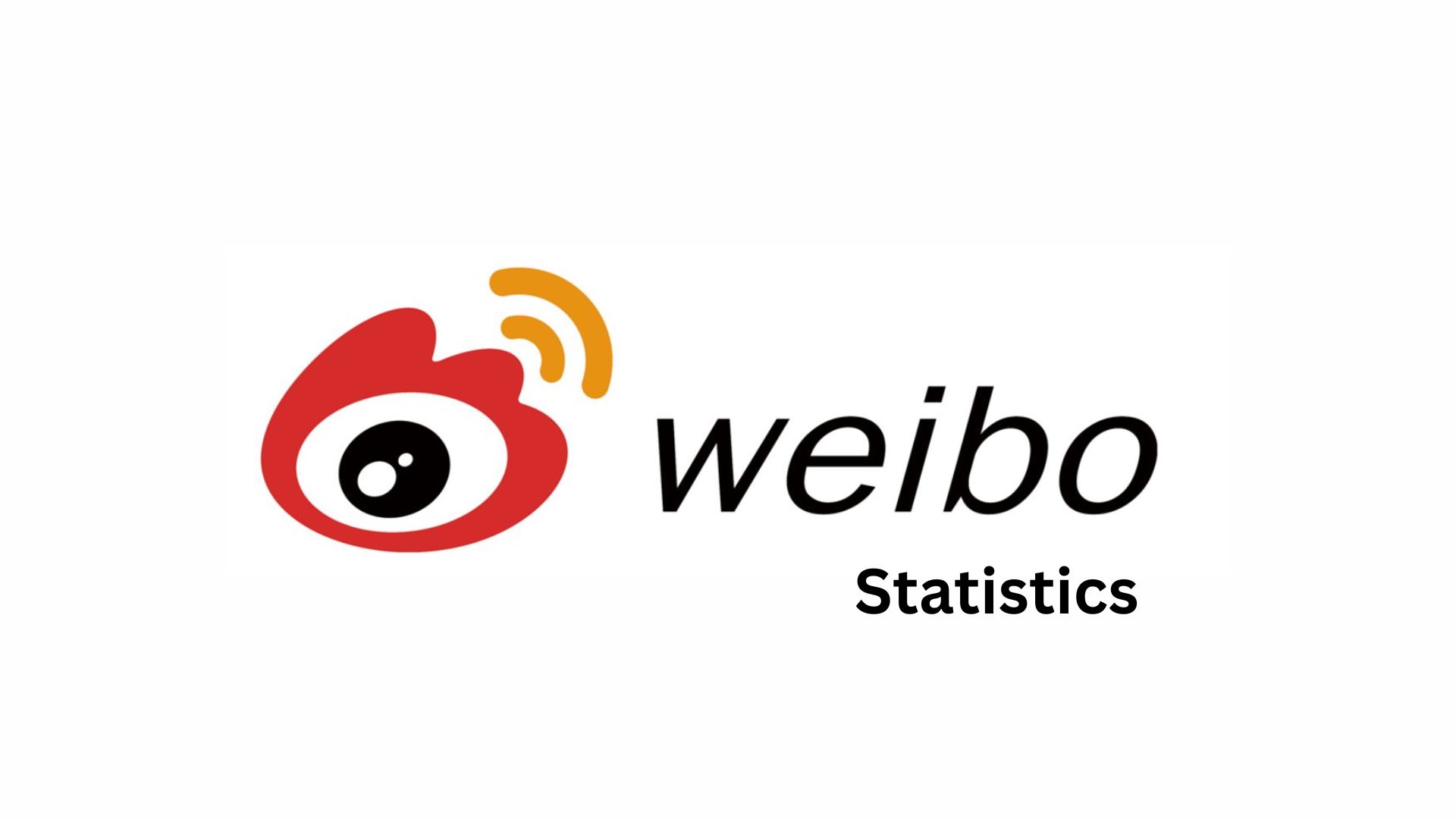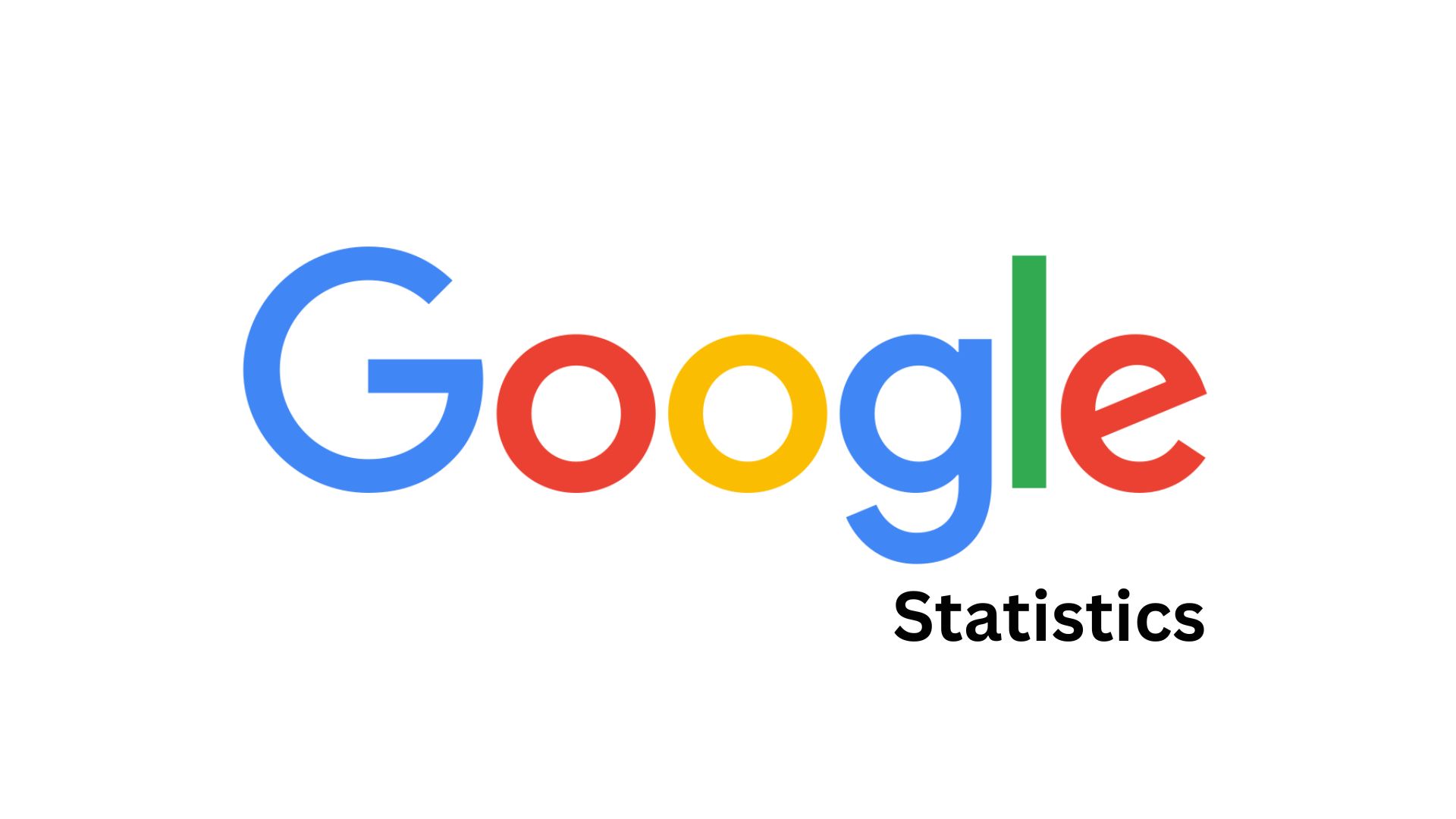Smart Speaker Statistics By Market Size, Share, Region, Usage, Adoption, Shipments, Ownership, Trends and Facts (2025)
Updated · Nov 04, 2025
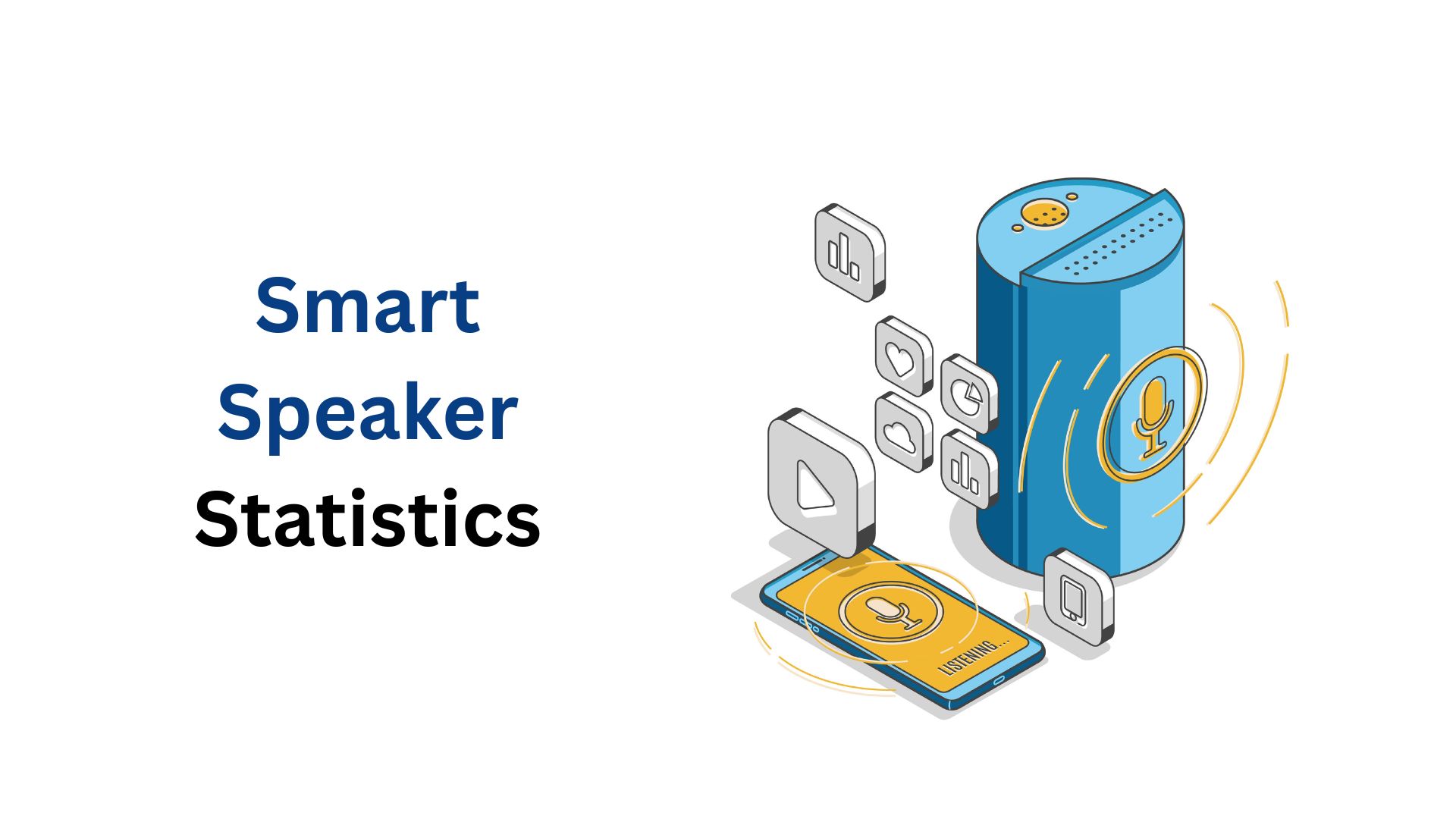
Table of Contents
- Introduction
- Editor’s Choice
- General Statistics
- Smart Speaker Market Size
- Smart Speaker Market Share Statistics By Region
- Top Smart Speakers Analyses, 2025
- Smart Speaker Usage Statistics
- Smart Speaker Adoption Statistics By Country
- Global Smart Speaker Shipments Statistics
- Top 10 Smart Speakers Price Analysis
- Reasons For Listening To Smart Speakers Statistics
- Smart Speaker Ownership By Brand
- Smart-Speaker Listening Time Statistics
- Highest-Rated Smart Speakers For Relaxing
- Top 10 Highest-Rated Smart Speakers For Home Cinema (January 2025)
- Place of Using Voice Assistants
- Awareness And Ownership Statistics
- Conclusion
Introduction
Smart Speaker Statistics: Smart speakers are no longer niche gadgets. They now sit in millions of living rooms and bedrooms as everyday helpers. Devices like Amazon Echo, Google Nest, Apple HomePod, and Sonos handle music, quick answers, and smart-home control for lights, plugs, TVs, security, and heating or cooling. This article gathers 2025 smart speaker statistics that can be used for market size, growth, global shipments, and household reach by region.
It also compares brands and operating systems, shows how people actually use them (listening, searching, shopping, automation), and looks at multi-device ownership and privacy risks. Finally, you’ll see the trends driving demand: smarter AI assistants, better far-field mics, multilingual features, support for Matter, and tighter links with major streaming apps that clear charts and solid sources included.
Editor’s Choice
- The global market size of Smart Speaker will reach around USD 21.4 billion by 2025, which increased from USD 17 billion in 2024.
- According to scoop.market.us, North America leads with 36.4%, Europe holds 18.0%, and Asia-Pacific (APAC) accounts for 25.4% of the market.
- As of 2024, Amazon captured the highest position in the smart speaker market, accounting for a share of 23%, followed by Apple (15%) and Alphabet ( 8%).
- Top smart speaker models of 2025 are Apple HomePod (2nd gen), Sonos Era 300, Sonos Era 100, Amazon Echo (4th gen), and Google Nest Audio.
- Edison Research reports that 35% of Americans aged 12 years, about 101 million people, own a smart speaker.
- In 2024, the strongest adoption rate was secured by India with a share of 20.9%, followed by the United States (20.7%) and the United Kingdom (18.3%).
- According to rab.com, around 49% choose one to keep children entertained, 63% enjoy discovering new songs, and 47% plan to listen to podcasts.
- TechInsights says global smart speaker and display shipments should grow at 4% in 2025, resulting in 156 million units.
- In March 2024, the United States’ ownership remained highest on Amazon Echo with 65%.
- The highest smart speaker ownership was captured by people aged between 45 and 54 years with a share of 24%, followed by 55+years at 22%.
- Among American listeners aged 13 years and above, smart speakers now command far more attention.
- In 2025, around 35% of people aged 12 years and above own at least one smart speaker.
General Statistics
- NPR/Edison Research’s Smart Audio Report notes that 35% of U.S. adults own a smart speaker.
- Amazon said Alexa-enabled device sales topped 500 million by May 2023.
- Oberlo estimates show 69.91 million U.S. households using smart-home devices in 2024, up 10.2% from 63.43 million in 2023.
- Sonos’ Era 100 and Era 300 anchored hi-fi, multi-room lineups highlighted in 2024 coverage.
- By late 2024, Google implemented AI for more natural nest interactions and improved audio experiences.
Smart Speaker Market Size
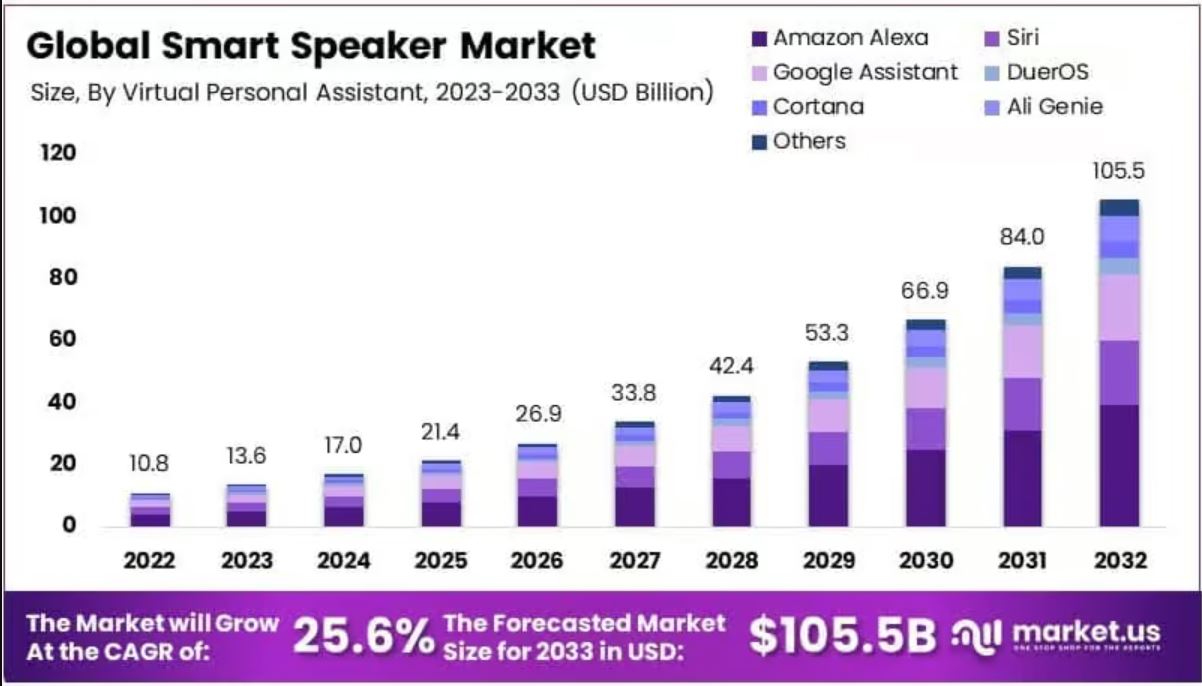
(Source: sp-ao.shortpixel.ai)
- The global market size of Smart Speaker will reach around USD 21.4 billion by 2025, which increased from USD 17 billion in 2024.
- The growth rate of the market will grow at a CAGR of 25.6% from 2024 to 2032, resulting in USD 105.5 billion by the end of 2032.
- Furthermore, in the coming years, this market is estimated to reach USD 26.9 billion in 2026, followed by USD 33.8 billion in 2027, USD 42.4 billion in 2028, USD 53.3 billion in 2029, USD 66.9 billion in 2030, and USD 84 billion in 2031.
- According to scoop.market.us, North America leads with 36.4%, Europe holds 18.0%, and Asia-Pacific (APAC) accounts for 25.4% of the market.
- The same source reports Latin America at 10.4% of the global share.
- Combined, the Middle East & Africa (MEA) contribute 9.8%.
By Key Players
- As of 2024, Amazon captured the highest position in the smart speaker market, accounting for a share of 23%, followed by Apple (15%) and Alphabet ( 8%).
- In the Chinese market, the top two players’ share was secured by Tmall Genie (17%) and AliGenie (12%).
- In contrast, other brands’ shares are followed by Bose (9%), Xiaomi (6%), Panasonic + other key players (6%), and the rest (4%).
Top Smart Speakers Analyses, 2025
| Model Names | Size / Weight | Audio | Wireless / Connectivity | Voice / Controls |
| Apple HomePod (2nd gen) | 6.6 in (168 mm) H × 5.6 in (142 mm) W; 5.16 lb (2.3 kg) | High-excursion woofer; 5 horn-loaded tweeters with beamforming; room sensing; Spatial Audio | 802.11n Wi-Fi, Bluetooth; Thread/Matter home hub via Home app | Touch surface; temperature & humidity sensors |
| Sonos Era 300 | 7.28 in × 10.24 in × 6.30 in; 185 mm × 260 mm × 160 mm; 9.85 lb; 4.47 kg | Six drivers (front/sides/top) for Dolby Atmos Music spatial audio | Wi-Fi, Bluetooth, USB-C line-in (adapter), AirPlay 2 | Sonos Voice Control; Alexa support |
| Sonos Era 100 | 7.19 in (182.5 mm) H × 4.72 in (120 mm) W × 5.14 in (130.5 mm) D; 4.45 lb (2.02 kg) | 3 drivers (dual tweeters + mid-woofer) | Wi-Fi, Bluetooth, USB-C line-in (adapter), AirPlay 2 | Sonos Voice Control; Alexa support |
| Amazon Echo (4th gen) | 5.7 × 5.7 × 5.2 in; 34.2 oz (around 970 g) | 3-in woofer + dual 0.8-in tweeters | Dual-band Wi-Fi, Bluetooth, 3.5 mm line in/out | Alexa: temp sensor |
| Google Nest Audio | 6.89 in (175 mm) H × 4.89 in (124 mm) W × 3.07 in (78 mm) D; 2.65 lb (1.2 kg) | 75 mm woofer + 19 mm tweeter | Dual-band Wi-Fi, Bluetooth, Chromecast built-in | Google Assistant voice control |
Smart Speaker Usage Statistics
- Edison Research reports that 35% of Americans aged 12 years, about 101 million people, own a smart speaker.
- The same web source finds 22% of Americans listened to audio on a smart speaker in the last month, and 18% did so in the last week.
- In the U.K., Ofcom/RAJAR indicates smart speakers account for 18% of live radio listening hours.
- From DemandSage surveys, around 52% of smart-speaker owners use their device daily.
- 52% place them in the family/common room, followed by 25% (bedroom), and 22% (kitchen).
- Over one-third of consumers say they use their speaker specifically for voice search.
- Ownership often expands beyond a single unit, as 41% of owners report having two additional speakers.
- In contrast, 59% own one speaker, 30% own two, 9% own three, 2% own four, and 1% own five.
- The Radio Advertising Bureau (rab.com) notes that among U.S. radio listeners, 28% stream stations via smart speakers.
Smart Speaker Adoption Statistics By Country
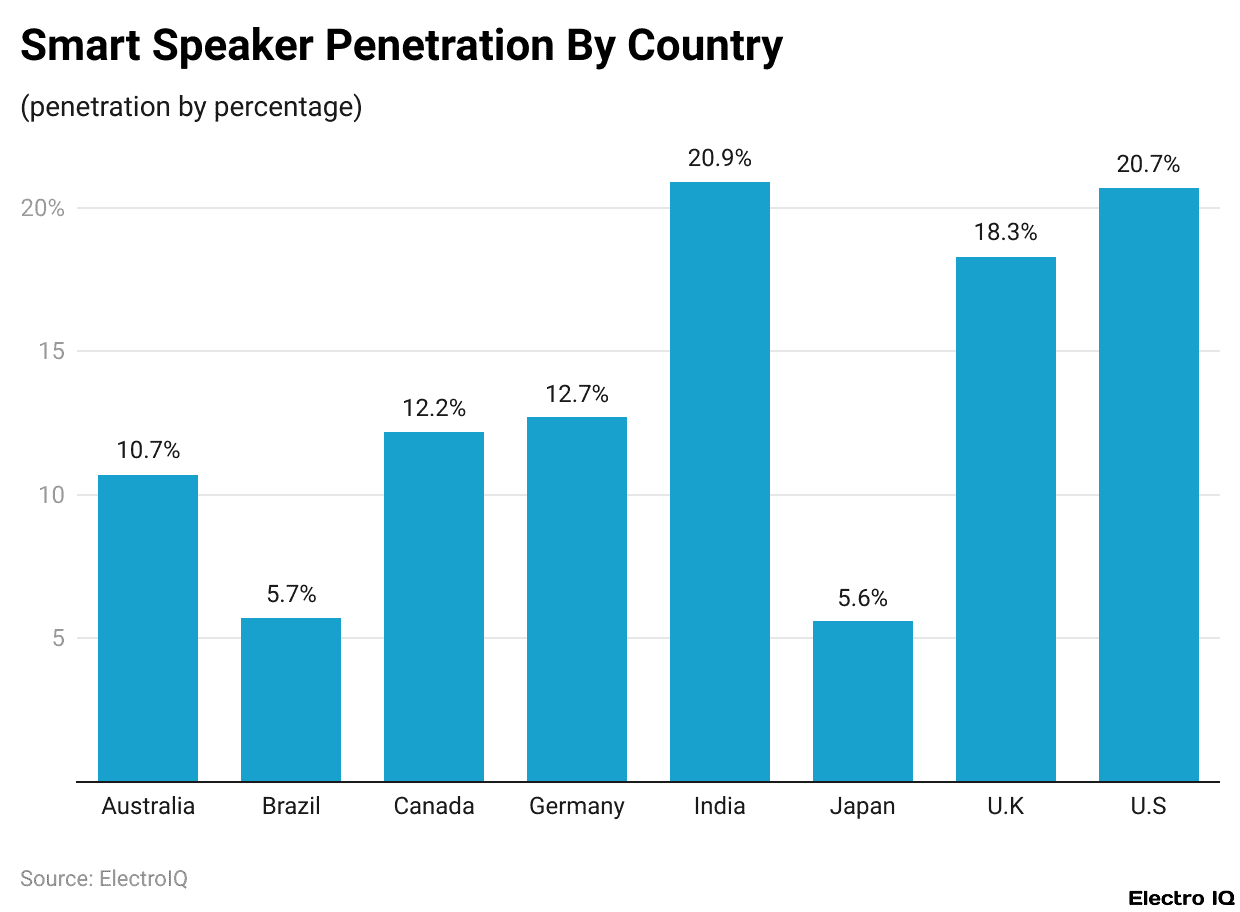
(Reference: scoop.market.us)
- In 2024, the largest adoption rate was secured by India with a share of 20.9%, followed by the United States (20.7%) and the United Kingdom (18.3%).
- Mid-tier adoption share was made up by Germany (12.7%), Canada (12.2%), and Australia (10.7%).
- Meanwhile, lower adoptions were seen in Brazil (5.7%) and Japan (5.6%).
Global Smart Speaker Shipments Statistics
- Strategy Analytics reported 86.2 million units in 2018 (via audioXpress), and a year later, sales hit a record 146.9 million in 2019 (BusinessWire/Strategy Analytics).
- For 2020 and 2021, S&P Global Market Intelligence projected about 166.2 million and 186 million units, respectively.
- According to Strategic Market Research, multiple roundups place 2022 near 171 million shipped.
- A report by Industry Research stated that in 2023, total shipments reached almost 205 million units.
- A GlobeNewswire/Yahoo Finance further shows that in 2024, approximately 150 million units of smart speakers were shipped.
- TechInsights says global smart speaker and display shipments should grow at 4% in 2025, resulting in 156 million units.
Top 10 Smart Speakers Price Analysis
| Model Name | Price (USD) |
| Apple HomePod (2nd gen) | 299 |
| Apple HomePod mini | 99 |
| Sonos Era 300 | 479 |
| Sonos Era 100 | 219 |
| Sonos Move 2 (portable) | 499 |
| Sonos Roam 2 (portable) | 179 |
| Amazon Echo (4th gen) | 99.99 |
| Amazon Echo Studio | 199.99 |
| Amazon Echo Dot (5th gen) | 49.99 |
| Google Nest Audio | 99.99 |
Reasons For Listening To Smart Speakers Statistics
- According to rab.com, around 49% choose one to keep children entertained, 63% enjoy discovering new songs, and 47% plan to listen to podcasts.
- Others see it as a 51% replacement for an old radio or a way to manage the home, with 53% preferring voice control for smart devices.
- Includes care needs, with 30% believing it helps older adults, and 24% consider it useful for disability support.
Smart Speaker Ownership By Brand
- In March 2024, the United States’ ownership remained highest on Amazon Echo with 65%.
- Google’s products followed Google Home at 24% and Google Nest at 17%.
- Meanwhile, Apple HomePod accounted for an ownership of 18%.
- Other premium audio brands’ shares are Bose (14%) and JBL’s Link Series (12%).
By Age Demographics
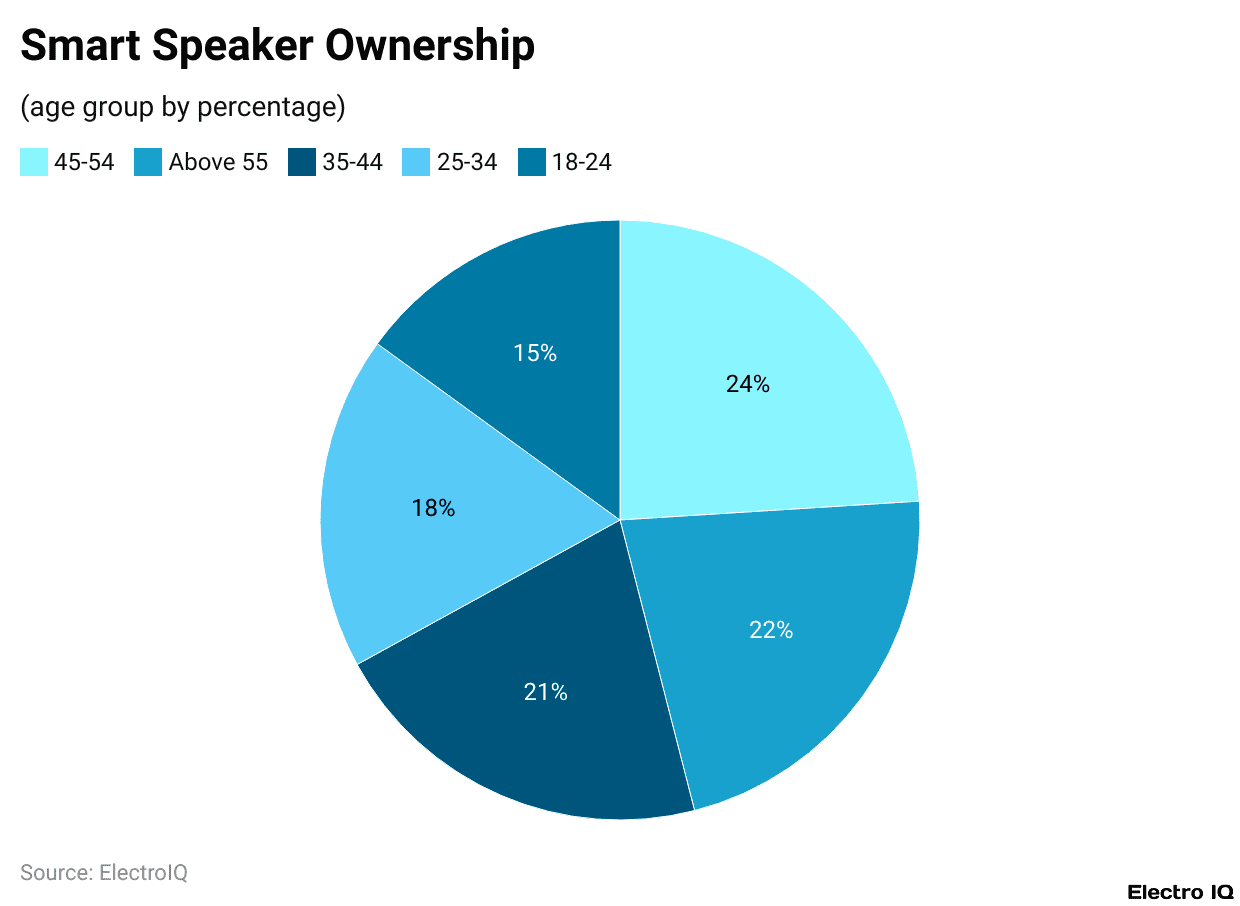
(Reference: scoop.market.us)
- The highest smart speaker ownership was captured by people aged between 45 and 54 years with a share of 24%, followed by 55+years at 22%.
- Furthermore, ownership user shares by age groups are 21% (35 to 44 years), 18% (25 to 34 years), and 15% (18 to 24 years).
Smart-Speaker Listening Time Statistics
- Among American listeners aged 13 years and above, smart speakers now command far more attention.
- The total time spent listening to all audio via a smart speaker has surged 400%, rising from one to five.
- Podcast listening through smart speakers has also accelerated, up 200%, moving from two to six.
Highest-Rated Smart Speakers For Relaxing
| Model Name | RATINGS Music Score |
| JBL Authentics 500 |
7.7 / 10
|
| Sonos Era 300 | |
| Denon Home 350 |
7.6 / 10
|
| Sonos Era 100 | |
| Bose Home Speaker 500 | 7.3 / 10 |
| Apple HomePod (2nd gen) | 7.2 / 10 |
| Amazon Echo Studio | 7.1 / 10 |
| Bose Portable Smart Speaker | 6.9 / 10 |
| Amazon Echo (4th gen) | 6.8 / 10 |
| Google Nest Audio | 6.2 / 10 |
Top 10 Highest-Rated Smart Speakers For Home Cinema (January 2025)
| Model Name | Movie Score |
| Bose Home Speaker 500 | 7.1 |
| Sonos Era 300 | 7 |
| JBL Authentics 500 |
6.9
|
| Sonos Era 100 | |
| Bose Home Speaker 300 | |
| Amazon Echo Studio |
6.1
|
| Amazon Echo (4th gen) | |
| Apple HomePod (2nd gen) | 6 |
| Google Nest Audio | 5.7 |
| Apple HomePod mini | 5.6 |
Place of Using Voice Assistants
- According to Demand Sage, in 2025, approximately 56% people use voice assistants on smartphones, 35% on smart speakers, 34% on TV/TV remotes, and 29% in cars.
- They’re also used by 24% on computers/laptops, 24% on tablets, and 12% through household appliances.
Awareness And Ownership Statistics
- In 2025, around 35% of people aged 12 years and above own at least one smart speaker.
- Besides, 22% listened to audio on a speaker in the last month, and 18% in the last week.
- Among radio audiences, 28% stream their favourite AM/FM stations via smart speakers.
- Meanwhile, 60% of adults 18 years+ who own speakers still listen to traditional AM/FM.
- In contrast, 43% of Millennials and 34% of Boomers report having a device, and 67% of smart-speaker owners live in households earning USD 75,000+.
Conclusion
Smart speakers have become home helpers, not add-ons. Growth in 2025 is steadier than the early boom, yet usage is richer: people stream music, ask quick questions, run lights and TVs, and link other devices. Success depends on assistant quality, privacy, Matter compatibility, and setup. Expect moderate shipment gains, higher adoption in Asia-Pacific, and more on-device AI for faster, private replies. Brands win with clear use cases, reliable voice flows, and tight links to streaming, shopping, and automation, while tracking retention, multi-device uptake, and trust.
FAQ.
They listen for a wake word, capture your request, process it on-device or in the cloud, then return an action or answer.
Play music/podcasts, answer questions, set timers/alarms, control lights/thermostats/TVs, make calls, run routines, and more.
Amazon Echo (Alexa), Google Nest (Google Assistant), Apple HomePod (Siri), plus Sonos and others.
Yes, you can create groups for multi-room audio and set room-specific routines.
Most support Spotify, YouTube Music, Apple Music, Audible, and radio, based on brand/region.

Maitrayee Dey has a background in Electrical Engineering and has worked in various technical roles before transitioning to writing. Specializing in technology and Artificial Intelligence, she has served as an Academic Research Analyst and Freelance Writer, particularly focusing on education and healthcare in Australia. Maitrayee's lifelong passions for writing and painting led her to pursue a full-time writing career. She is also the creator of a cooking YouTube channel, where she shares her culinary adventures. At Smartphone Thoughts, Maitrayee brings her expertise in technology to provide in-depth smartphone reviews and app-related statistics, making complex topics easy to understand for all readers.





